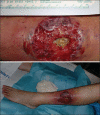Pyoderma gangrenosum: a commonly overlooked ulcerative condition
- PMID: 25657946
- PMCID: PMC4311345
- DOI: 10.4103/2249-4863.148113
Pyoderma gangrenosum: a commonly overlooked ulcerative condition
Abstract
Background: Pyoderma ga ngrenosum (PG) is a rare, inflammatory, destructive neutrophilic dermatosis, which mimics other ulcerative conditions.
Materials and methods: In a retrospective study based on patients diagnosed with PG over a 3-year period (2010-2013), we evaluated demographics, anatomical sites, number of lesions, subtypes, histopathology, associated conditions, treatment regimens, healing time, and recurrence.
Results: Of our five patients, there were three males and two females, age ranging between 19 and 58 years (mean age 38 years). Four had single lesions localized to the lower limbs while one had multiple lesions (more than five) over bilateral hands and legs. Ulcerative subtype was observed in all the patients. One exhibited pathergy. Skin biopsies were done in four patients, revealing dense neutrophilic infiltrates in three cases and leukocytoclastic vasculitis in one. Associated systemic diseases were observed in all patients, four having inflammatory bowel disease and one having both systemic lupus erythematosus and anti-phospholipid syndrome. The patients were all treated with systemic corticosteroids either alone or in combination with immunosuppressants (e.g., azathioprine, mycophenolate mofetil, tacrolimus), and wound dressing. Split-thickness skin graft was done in one patient. Complete healing was achieved in all patients, ranging from one to 3 months after diagnosis. No recurrence was reported.
Conclusions: Systemic corticosteroids, either alone or in combination with steroid-sparing agents are the mainstay of treatment. Should family physicians encounter a rapidly progressing ulcer that has poor response to usual wound management, timely referral to dermatology should be made.
Keywords: Bluish edge; painful; pyoderma gangrenosum; rapid progression; ulcer.
Conflict of interest statement
Figures


Similar articles
-
Generalized Pyoderma Gangrenosum Associated with Ulcerative Colitis: Successful Treatment with Infliximab and Azathioprine.Acta Dermatovenerol Croat. 2016 Apr;24(1):83-5. Acta Dermatovenerol Croat. 2016. PMID: 27149138
-
Management of Idiopathic Pyoderma Gangrenosum With Azathioprine As the Primary Adjunct in an Asian Man: A Case Report.Cureus. 2022 May 21;14(5):e25177. doi: 10.7759/cureus.25177. eCollection 2022 May. Cureus. 2022. PMID: 35746991 Free PMC article.
-
Neutrophilic dermatoses: a review of current treatment options.Am J Clin Dermatol. 2009;10(5):301-12. doi: 10.2165/11310730-000000000-00000. Am J Clin Dermatol. 2009. PMID: 19658442 Review.
-
Pyoderma Gangrenosum: An Ulcer With Unorthodox Treatment.Cureus. 2021 Nov 7;13(11):e19324. doi: 10.7759/cureus.19324. eCollection 2021 Nov. Cureus. 2021. PMID: 34900493 Free PMC article.
-
Clinical management of pyoderma gangrenosum.Am J Clin Dermatol. 2002;3(3):149-58. doi: 10.2165/00128071-200203030-00002. Am J Clin Dermatol. 2002. PMID: 11978136 Review.
Cited by
-
Surgical Treatment of Pyoderma Gangrenosum with Negative Pressure Wound Therapy and Skin Grafting, Including Xenografts: Personal Experience and Comprehensive Review on 161 Cases.Adv Wound Care (New Rochelle). 2020 Jul;9(7):405-425. doi: 10.1089/wound.2020.1160. Epub 2020 Apr 28. Adv Wound Care (New Rochelle). 2020. PMID: 32320362 Free PMC article. Review.
-
Pyoderma Gangrenosum after Breast Cancer Resection: A Less-invasive and Early Treatment Using the Skin around Ulcers.Plast Reconstr Surg Glob Open. 2022 Feb 15;10(2):e4111. doi: 10.1097/GOX.0000000000004111. eCollection 2022 Feb. Plast Reconstr Surg Glob Open. 2022. PMID: 35186644 Free PMC article.
-
Pyoderma gangrenosum associated with limited cutaneous systemic sclerosis: a rare case with literature review.Clin Rheumatol. 2021 Mar;40(3):1141-1145. doi: 10.1007/s10067-020-05285-z. Epub 2020 Jul 16. Clin Rheumatol. 2021. PMID: 32676919 Review.
References
-
- Ruocco E, Sangiuliano S, Gravina AG, Miranda A, Nicoletti G. Pyoderma gangrenosum: An updated review. J Eur Acad Dermatol Venereol. 2009;23:1008–17. - PubMed
-
- Pereira N, Brites MM, Gonçalo M, Tellechea O, Figueiredo A. Pyoderma gangrenosum – A review of 24 cases observed over 10 years. Int J Dermatol. 2013;52:938–45. - PubMed
-
- De Menezes D, Yusuf E, Borens O. Pyoderma gangrenosum after minor trauma in a pregnant woman, mistaken for necrotizing fasciitis: Report of a case and literature review. Surg Infect (Larchmt) 2014;15:441–4. - PubMed
-
- El-Kehdy J, Haneke E, Karam PG. Pyoderma gangrenosum: A misdiagnosis. J Drugs Dermatol. 2013;12:228–30. - PubMed
LinkOut - more resources
Full Text Sources
Other Literature Sources

